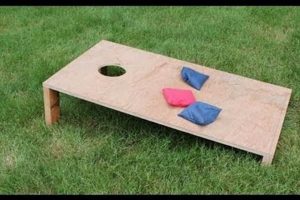A self-assembled sensor designed to halt a 3D printer when the filament supply is depleted. This device, constructed from readily available components, monitors the presence of filament feeding into the printer. Upon detecting the absence of filament, it sends a signal to the printer’s control board, initiating a pause in the printing process. An example includes an optical sensor that triggers when the filament no longer obstructs a light beam, signalling a runout condition.
Implementing such a system mitigates print failures caused by empty filament spools. It prevents wasted material and time associated with incomplete prints, improving overall efficiency and reducing operational costs. This approach evolved as a cost-effective solution for users seeking to enhance the reliability of their 3D printing workflows without relying on expensive, pre-built commercial options. Early implementations were often based on basic mechanical switches, later evolving to more sophisticated optical and Hall-effect sensors.
The following sections will detail the various sensor technologies employed in these systems, explore the common electronic components involved, and provide step-by-step instructions for building and integrating such a device with popular 3D printer models. Software considerations for interfacing the sensor with printer firmware will also be discussed.
Tips for Implementing a Filament Runout Detection System
The following provides practical guidance for designing, building, and integrating a filament depletion sensor into a 3D printing setup, enhancing print reliability and reducing material waste.
Tip 1: Sensor Selection: Consider optical, mechanical, or Hall-effect sensors based on budget, complexity, and desired sensitivity. Optical sensors are generally more accurate but can be affected by dust, while mechanical switches are simpler but may introduce friction. Hall-effect sensors offer non-contact detection but require careful calibration.
Tip 2: Mounting Design: Design a sturdy mount that securely positions the sensor in the filament path. Ensure the mount does not obstruct filament movement or introduce unnecessary friction. A well-designed mount is crucial for consistent performance and reliable triggering.
Tip 3: Wiring and Connections: Use appropriate gauge wiring and secure connectors for all electrical connections. Improper wiring can lead to intermittent sensor failures or signal noise. Consider using shielded cables to minimize electromagnetic interference.
Tip 4: Firmware Integration: Configure the printer’s firmware to recognize the signal from the sensor. This typically involves enabling a specific pin on the control board and setting the appropriate trigger level. Incorrect firmware settings can prevent the sensor from functioning correctly.
Tip 5: Calibration and Testing: Thoroughly calibrate the sensor after installation. Test the system by allowing the printer to run until the filament is depleted. Verify that the printer pauses correctly and issues the appropriate warning. Proper calibration ensures accurate and timely runout detection.
Tip 6: Material Compatibility: Ensure the selected sensor is compatible with the types of filaments used. Some sensors may be less reliable with flexible or transparent filaments. Adjust sensor sensitivity as needed based on the filament properties.
Tip 7: Signal Debouncing: Implement signal debouncing in either hardware or software to prevent false triggers caused by vibrations or electrical noise. This can be achieved using a capacitor in hardware or by filtering the signal in the firmware.
Implementing these tips will contribute to a more reliable and efficient filament depletion sensing system, reducing print failures and saving valuable resources. Meticulous attention to detail during the design and implementation phases is paramount.
The subsequent steps involve integrating the sensor output with the printer’s control system, a critical phase that is discussed in detail within the articles later sections.
1. Sensor Selection
The selection of an appropriate sensor is fundamental to the successful construction and operation of a do-it-yourself filament runout detection system. The sensor’s characteristics directly influence the system’s accuracy, reliability, and compatibility with various 3D printing materials. Careful consideration must be given to the operational principles and limitations of different sensor types to ensure optimal performance.
- Optical Sensors
Optical sensors utilize light beams to detect the presence or absence of filament. When filament is present, it blocks the light beam, triggering a signal. Conversely, when the filament runs out, the beam passes through, indicating a runout condition. While offering high sensitivity, optical sensors are susceptible to environmental factors such as dust accumulation, which can lead to false triggers. In practice, this necessitates regular cleaning and maintenance to maintain reliable operation.
- Mechanical Switches
Mechanical switches, often lever- or roller-based, rely on physical contact with the filament. As the filament passes, it actuates the switch, maintaining a closed circuit. Filament depletion causes the switch to open, signaling a runout. These switches are generally robust and cost-effective, but they introduce friction into the filament path, potentially impacting print quality, particularly with flexible materials. Furthermore, the switch’s lifespan is limited by the mechanical wear associated with repeated actuation.
- Hall-Effect Sensors
Hall-effect sensors detect changes in a magnetic field. By embedding a small magnet within the filament path, the presence of filament can be inferred without direct physical contact. These sensors offer a non-contact approach, minimizing friction and wear. However, they require careful calibration to account for variations in filament diameter and material composition. Sensitivity to external magnetic fields also necessitates shielding to prevent interference.
- Capacitive Sensors
Capacitive sensors measure the capacitance of a small volume in the filament path. The presence of filament changes the capacitance, which is then detected by the sensor. These sensors are non-contact and can be sensitive to small changes in filament presence. However, they can be affected by humidity and require careful calibration to avoid false positives or negatives.
The choice of sensor directly influences the overall effectiveness of the filament runout detection system. Understanding the strengths and weaknesses of each sensor type, and matching the sensor to the specific 3D printing application, ensures a reliable and efficient solution for preventing print failures due to filament depletion.
2. Mounting Stability
Mounting stability is a critical determinant of performance for any self-assembled filament runout detection system. A secure and appropriately positioned mounting assembly ensures accurate and reliable detection of filament depletion, directly impacting the overall effectiveness of the system.
- Minimizing Vibrational Interference
In a 3D printing environment, vibrations are inherent due to the movement of the print head and platform. An unstable sensor mount can amplify these vibrations, leading to false triggering of the runout detection system. For example, a loosely mounted optical sensor might intermittently block its own light beam due to vibration, falsely indicating filament depletion. Therefore, a rigid mounting solution is essential to isolate the sensor from external vibrations and ensure accurate detection of genuine filament runout events.
- Maintaining Consistent Filament Path Alignment
The mounting assembly must maintain a consistent and predictable filament path through the sensor. Deviations in the filament’s trajectory can affect the sensor’s ability to accurately detect its presence or absence. For instance, if a mechanical switch is not precisely aligned with the filament path, the filament may intermittently lose contact with the switch, resulting in erroneous runout signals. A well-designed mount ensures proper alignment and prevents such inconsistencies.
- Preventing Sensor Displacement
The forces exerted by the filament as it is pulled through the sensor can, over time, displace an inadequately secured mount. This displacement can lead to misalignment and inaccurate sensor readings. As an example, a poorly attached Hall-effect sensor might gradually shift position, altering the magnetic field it detects and triggering false alarms. A robust mounting solution, using appropriate fasteners and materials, prevents sensor displacement and maintains long-term stability.
- Material Selection and Resonance
The material used for the mounting structure can influence its stability. Materials with inherent resonance frequencies near the operating frequencies of the 3D printer can amplify vibrations, negating the benefits of a secure mount. For example, using a thin, flexible plastic for the mount could inadvertently create a resonant structure that exacerbates vibration-induced errors. Careful material selection, considering factors such as stiffness and damping properties, is crucial for minimizing resonance and enhancing overall stability.
Therefore, achieving optimal performance from a homemade filament runout sensor hinges on implementing a mounting solution that minimizes vibrational interference, maintains consistent filament path alignment, prevents sensor displacement, and considers the resonant properties of the mounting material. These factors collectively contribute to a reliable and accurate system for detecting filament depletion.
3. Wiring Integrity
Wiring integrity constitutes a foundational element in the effective operation of a self-assembled filament runout detection system. Reliable signal transmission between the sensor and the 3D printer’s control board is entirely dependent on the quality and robustness of the wiring infrastructure. Compromised wiring can introduce signal degradation, intermittent failures, and ultimately, a non-functional or unreliable detection system.
- Connector Reliability
The connectors used to interface the sensor with the control board represent potential points of failure. Loose connections, corrosion, or poorly crimped terminals can interrupt signal flow, leading to erratic behavior. For example, a loose Dupont connector can intermittently disconnect, causing the printer to pause unexpectedly or fail to recognize a genuine filament runout event. Implementing secure and reliable connectors, such as locking JST connectors or professionally crimped terminals, is crucial for maintaining consistent signal transmission.
- Wire Gauge and Insulation
The gauge of the wiring must be appropriate for the current and voltage requirements of the sensor. Undersized wiring can overheat and degrade, while inadequate insulation can lead to short circuits. Using the correct wire gauge, typically 22-24 AWG for low-current sensor applications, and ensuring proper insulation are essential safety precautions. Furthermore, high-quality insulation protects the signal from external interference and physical damage.
- Signal Shielding
In electrically noisy environments, such as those surrounding a 3D printer with stepper motors and switching power supplies, signal shielding can mitigate the effects of electromagnetic interference (EMI). Unshielded wiring can pick up stray signals, leading to false positives or negatives in the runout detection system. Employing shielded cables, with the shield properly grounded, effectively blocks EMI and ensures a clean signal transmission. An example would be using a shielded cable to connect an optical sensor that’s located close to a stepper motor driver.
- Strain Relief
The points where wires connect to the sensor and the control board are subject to mechanical stress from bending and movement. Without adequate strain relief, the wires can fatigue and break, leading to intermittent or permanent failures. Implementing strain relief mechanisms, such as cable ties or adhesive-lined heat shrink tubing, prevents stress from being concentrated at the connection points, extending the lifespan of the wiring and ensuring reliable signal transmission. A practical example is securing the wires leading into the sensor housing with a cable tie to prevent them from being pulled out.
These facets underscore the significance of meticulous attention to wiring details when constructing a self-assembled filament runout detector. Reliable connectors, appropriate wire gauge and insulation, signal shielding, and strain relief collectively contribute to a robust and dependable system, minimizing the risk of print failures due to faulty signal transmission.
4. Firmware Configuration
The successful integration of a self-assembled filament runout detector hinges critically on proper firmware configuration within the 3D printer’s control system. The firmware acts as the interpreter, translating the sensor’s output into a specific action, typically pausing the print and alerting the user. Incorrect firmware settings render the hardware ineffective, as the control board remains oblivious to the filament’s absence. For instance, if the firmware is not configured to monitor the correct input pin where the sensor signal is connected, the printer will continue printing even after the filament has run out, resulting in a failed print. Therefore, configuring the firmware accurately establishes the essential communication pathway between the hardware and the printer’s operational logic.
Specifically, firmware configuration involves defining the pin on the control board that receives the sensor signal, determining the active state (high or low) that signifies filament runout, and enabling the runout detection feature within the firmware’s settings. The commonly used Marlin firmware, for example, requires uncommenting specific lines in the `Configuration.h` file to
define the `FILAMENT_RUNOUT_SENSOR` and the `FIL_RUNOUT_PIN`. It also necessitates setting `FILAMENT_RUNOUT_INVERTING` to `true` or `false` depending on whether the sensor signal is normally high or low. Additionally, the firmware offers options for retracting the filament upon runout detection to prevent nozzle clogging and for displaying a message on the printer’s LCD screen. If these parameters are not correctly defined and enabled, the printer will simply ignore the signal from the filament sensor, making the detector non-functional. Further, some advanced firmwares allows adding an additional delay on the activation of the sensor as to compensate for small filament gaps and prevent false positives.
In summary, precise firmware configuration is not merely a step in the process but the linchpin that connects the hardware and software components of the system. It is essential to carefully review the printer’s firmware documentation and configure the settings accurately to ensure that the filament runout detector functions as intended, preventing wasted material and ensuring successful print completion. Failure to address this aspect negates all efforts in hardware assembly and calibration.
5. Calibration Precision
Calibration precision is an indispensable element in the effective operation of a self-assembled filament runout detection system. The accuracy with which the system is calibrated directly influences its ability to reliably detect filament depletion and trigger the appropriate response. Imprecise calibration can lead to both false positives, where the printer pauses unnecessarily, and false negatives, where the printer continues printing despite the absence of filament, resulting in print failures. For example, in an optical sensor-based system, the threshold at which the light beam registers as blocked or unblocked must be accurately set. If the threshold is too sensitive, ambient light fluctuations may trigger a false runout signal. Conversely, if it is insufficiently sensitive, the sensor may fail to detect the absence of filament, leading to an incomplete print. Therefore, meticulous calibration is essential for the system to perform its intended function reliably.
The practical implications of calibration precision extend beyond simply preventing print failures. Accurate calibration minimizes wasted material by ensuring that the printer pauses promptly upon filament depletion, preventing the extrusion of incomplete layers. It also reduces the need for constant monitoring of the printing process, freeing up the user’s time and attention. Furthermore, precise calibration allows the system to be adapted to different types of filaments with varying opacities and diameters. For instance, transparent filaments may require a different calibration setting compared to opaque filaments to ensure accurate detection. Failure to recalibrate the system when switching between filament types can lead to unreliable performance. Calibration procedures often involve iterative adjustments to the sensor’s sensitivity and testing with different filament samples to ensure consistent and accurate detection across a range of printing conditions.
In conclusion, calibration precision is not a peripheral detail but rather a fundamental requirement for the proper functioning of a do-it-yourself filament runout detection system. Addressing this aspect meticulously is critical for preventing print failures, minimizing material wastage, and ensuring a smooth and efficient 3D printing workflow. While the challenges associated with achieving precise calibration can be significant, the benefits of a well-calibrated system far outweigh the effort required. A solid understanding of the underlying principles and careful adherence to calibration procedures are essential for realizing the full potential of self-assembled filament runout detectors.
6. Material Compatibility
Material compatibility is a significant consideration in the design and implementation of any self-assembled filament runout detector. The sensor’s ability to accurately detect the presence or absence of filament is inherently linked to the physical and optical properties of the filament itself. Incompatibility can lead to unreliable performance and potentially negate the benefits of the system.
- Optical Sensor Transparency
Optical sensors rely on the interruption of a light beam to detect filament presence. Transparent or translucent filaments can allow a significant portion of the light to pass through, potentially preventing the sensor from registering a runout condition. For example, clear PETG or some translucent PLA filaments might require adjustments to the sensor’s sensitivity or necessitate the use of a different sensor type altogether.
- Mechanical Sensor Friction
Mechanical sensors, which typically employ a lever or switch, introduce friction into the filament path. Filaments with high flexibility or a soft surface may experience increased drag, potentially affecting print quality. Furthermore, abrasive filaments can accelerate wear on the sensor’s moving parts. Selecting a mechanical sensor with appropriate materials and low friction components is crucial for ensuring compatibility.
- Filament Diameter Variation
Filament diameter variation can affect the consistency of runout detection, particularly with sensors that rely on precise filament positioning. Significant deviations from the nominal diameter can lead to intermittent contact with the sensor, resulting in false triggers or missed detections. Maintaining consistent filament diameter and adjusting the sensor’s position accordingly are essential for reliable operation.
- Conductive Filament Interference
Certain specialty filaments, such as those infused with carbon fiber or metal particles, possess conductive properties. These properties can potentially interfere with some sensor types, particularly those that rely on electrical measurements. Shielding or alternative sensor technologies may be required to mitigate this interference and ensure accurate runout detection.
Addressing material compatibility is a crucial step in ensuring the reliable operation of a homemade filament runout sensor. While the design may be innovative and the implementation meticulous, selecting an incompatible sensor material with the intended print materials can undermine the entire system, leading to wasted time and resources. Careful consideration of filament properties and sensor characteristics is therefore essential.
Frequently Asked Questions
The following addresses common inquiries regarding the construction and implementation of a do-it-yourself filament runout detection system.
Question 1: What are the primary benefits of constructing a filament runout detection system?
A self-assembled filament runout detector primarily mitigates material waste and prevents incomplete prints caused by filament exhaustion. It allows for unattended printing operations without the risk of failed jobs due to empty spools, saving both time and material.
Question 2: What are the essential components required for building a basic filament runout detector?
A basic system typically requires a sensor (optical, mechanical, or Hall-effect), a mounting bracket, wiring, connectors, and potentially a resistor. Integration wi
th the printer necessitates firmware modification or configuration of existing runout detection parameters.
Question 3: Which sensor type is generally considered the most reliable for detecting filament runout?
The reliability of a sensor depends on the specific application and environment. Optical sensors offer high sensitivity but can be susceptible to dust, while mechanical switches are robust but introduce friction. Hall-effect sensors offer a non-contact approach but require careful calibration. The optimum choice is dependent on the user’s specific criteria.
Question 4: Is it necessary to modify the 3D printer’s firmware to utilize a self-assembled filament runout detector?
In most instances, firmware modification or configuration is required. The firmware must be configured to recognize the signal from the sensor and initiate a pause in the printing process upon filament depletion. Pre-existing runout detection functionality, if available, needs proper configuration to interface with the new sensor.
Question 5: What are the common causes of false triggers in a filament runout detection system?
False triggers can arise from vibrational interference, electrical noise, dust accumulation (in optical sensors), or improper sensor calibration. Implementing vibration dampening, signal shielding, and regular sensor maintenance can mitigate these issues.
Question 6: What safety precautions should be observed when constructing and installing a filament runout detector?
Ensure the printer is powered off during wiring and component installation. Use appropriate gauge wiring and secure connectors to prevent short circuits. Exercise caution when modifying firmware to avoid damaging the printer’s control board. The safe operation of electrical devices is paramount.
In conclusion, constructing a reliable and effective do-it-yourself filament runout detector demands careful attention to component selection, wiring, firmware configuration, and calibration. Addressing these aspects meticulously ensures optimal performance and prevents common issues associated with such systems.
The following sections will delve into troubleshooting common issues encountered during the implementation of a filament runout detection system.
Conclusion
This exploration has detailed the various facets of constructing a do-it-yourself filament runout detector. The effectiveness of such a system hinges on the judicious selection of sensor technology, stable mounting, meticulous wiring, accurate firmware configuration, precise calibration, and rigorous material compatibility considerations. Successful implementation demands a comprehensive understanding of these interconnected elements, as weaknesses in any one area can compromise the system’s overall performance. Each stage, from sourcing components to integrating the sensor output with printer controls, requires disciplined execution.
The proliferation of affordable 3D printing technology necessitates increasingly sophisticated methods of process control. The ability to autonomously detect and respond to filament depletion represents a significant step toward enhanced print reliability and reduced material waste. Further advancements in sensor technology and firmware integration are likely to improve the ease of implementation and reliability of these systems, allowing for broader adoption within the 3D printing community. Diligence and continuous learning in this arena are critical for realizing the full potential of additive manufacturing.







